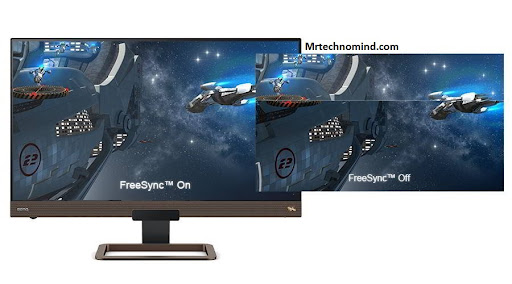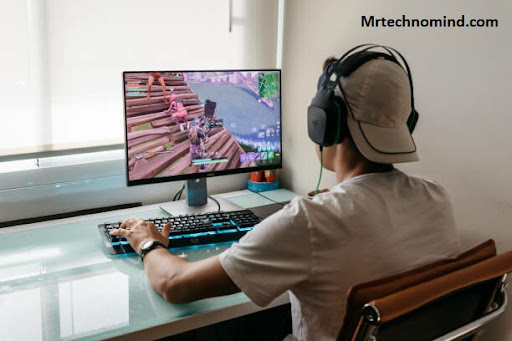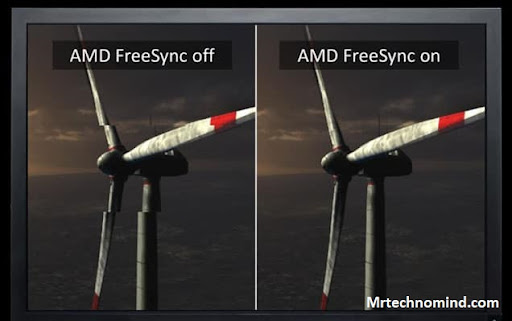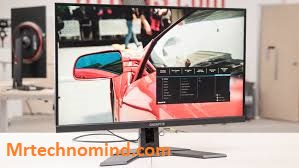What is Freesync and What Does It Do?

The world of gaming and graphics technology can be overwhelming.
One of the most important parts of any gaming setup is the monitor, and there’s a lot to consider when looking for one.

FreeSync is an important feature to look out for, but what exactly is it?
In this article, we’ll explain what FreeSync is and what it does.
FreeSync is a variable refresh rate technology developed by AMD that helps reduce screen tearing and stuttering in games.
It works with compatible monitors to synchronize the refresh rate of the display with the output from your computer’s graphics card.
By doing this, it eliminates artifacts like screen tearing and stuttering which can make gaming difficult and frustrating.
We’ll look further into how this works in more detail later on.
What is Freesync?

Gazing out the window, you notice a smooth, seamless transition in the movement of the clouds. The sun’s rays dance across the sky in perfect harmony, never skipping a beat.
This is much like AMD FreeSync, an adaptive synchronization technology that helps bring smooth gaming visuals to your PC or laptop. FreeSync eliminates tearing and stuttering between a monitor’s refresh rate and a graphics card’s frame rate—creating an uninterrupted gameplay experience.
It helps match up the performance of compatible monitors with compatible graphics cards—so you can expect tear-free, responsive gaming experiences. With AMD FreeSync, you can also enjoy reduced input latency for improved responsiveness during fast-paced games.
So whether it’s competitive first-person shooters or intense racing titles, you can count on AMD FreeSync to help deliver smooth visuals without any disruptions. Moving onto what exactly AMD FreeSync does?
What Does Amd Freesync Do?

AMD FreeSync is a technology developed by AMD to reduce motion stutter and screen tearing in video games. It does this by synchronizing the framerate of a game with the refresh rate of a monitor, creating an overall smoother gaming experience.
Here are some key features of AMD FreeSync:
– It helps eliminate motion blur and artifacts that can occur during gameplay.
– It can help reduce input lag, which is caused by the time it takes for a frame to be displayed onscreen.
– It helps maintain consistent frame rates even when the graphics settings or framerate dips below the monitor’s refresh rate.
AMD FreeSync also has several advantages over its competitors’ technologies, such as G-SYNC and V-SYNC. By using adaptive synchronization, FreeSync is able to provide a more fluid gaming experience without any additional input lag or screen tearing. This makes it an ideal choice for gamers who want smooth performance without sacrificing image quality.
Without further ado, let’s move on to discussing lfc (low framerate compensation) and how it works with AMD FreeSync monitors.
LFC (Low Framerate Compensation)

AMD FreeSync is an adaptive synchronization technology that helps reduce image tearing and stuttering while gaming. It works by synchronizing the refresh rate of your monitor with the frames per second (FPS) output of your GPU. This allows for a smooth and seamless gaming experience without any input lag or screen tearing.
LFC (Low Framerate Compensation) is an additional feature of AMD FreeSync that compensates for frame rates below the minimum required for proper synchronization between the GPU and monitor. This helps to ensure a smooth gaming experience even when your frame rate drops below the minimum value needed to maintain synchronization.
The result is a smooth, tear-free gaming experience regardless of how demanding the game is or how intense the action gets. AMD FreeSync has been proven to provide gamers with a much smoother and more immersive gaming experience compared to traditional V-sync technology, as well as improved performance in certain games due to reduced input lag.
With LFC, gamers can enjoy an even smoother experience regardless of how low their FPS dips during intense action sequences. This makes AMD FreeSync not only superior to traditional V-sync but also more versatile than NVIDIA’s G-Sync, offering users a truly unparalleled gaming experience. From here we’ll explore the differences between AMD FreeSync and NVIDIA G-Sync in further detail.
AMD Freesync Vs Nvidia G-sync

AMD FreeSync and NVIDIA G-SYNC are competing technologies that enable smoother gaming experiences on displays.
| Feature | AMD Freesync | Nvidia G-Sync |
| How it works | Uses Adaptive-Sync technology to sync the graphics card and the monitor’s refresh rate | Nvidia’s hardware-based technology provides precise frame timing to reduce screen tearing and stuttering |
| Supported Monitors | Supports a wide range of monitors, including budget-friendly options | Limited support to monitors with Nvidia’s proprietary hardware module |
| Graphics Cards | Compatible with AMD graphics cards | Compatible with Nvidia graphics cards |
| Performance | Offers variable refresh rate (VRR) to reduce screen tearing and stuttering | Offers VRR and ultra-low motion blur (ULMB) to reduce motion blur |
| Cost | Typically less expensive due to open-source technology | Typically more expensive due to the proprietary hardware module |
| Availability | More widely available on monitors, televisions, and laptops | More limited availability on monitors and laptops |
One of the main advantages of AMD FreeSync is that it’s an open-source technology, meaning it’s often cheaper than G-SYNC. G-SYNC, on the other hand, is proprietary and usually results in a higher cost.
Additionally, FreeSync can be used with more types of displays than G-SYNC. Both technologies provide a smoother gaming experience, but G-SYNC is more advanced, providing better performance with low framerate compensation.
When it comes to a cost comparison, G-SYNC monitors often come at a higher price tag than FreeSync ones. However, the overall performance delivered by G-SYNC is often worth the extra cost.
Advantages of Amd Freesync
When it comes to gaming, having a smooth and lag-free experience is key. One way to ensure this is with AMD FreeSync technology. It’s an adaptive synchronization technology that allows the display of a monitor to be synchronized with the graphics card for better visual performance.
Let’s explore why AMD FreeSync is superior to NVIDIA G-SYNC when it comes to gaming.
One of the main advantages of using an AMD FreeSync monitor over its NVIDIA G-SYNC counterpart is cost. Since AMD FreeSync works only with certain AMD GPUs, manufacturers don’t have to include expensive chips in their monitors which keeps costs down. This makes them more affordable than NVIDIA G-SYNC monitors, making them a great choice for gamers on a budget. Additionally, since there’s no need for complex hardware, setup, and operation are also much simpler than with G-SYNC monitors.
Finally, another benefit of using an AMD FreeSync monitor is the wider selection available compared to G-SYNC models. Not only do you get more choices in terms of size and style but you also have access to more features and capabilities like higher refresh rates, better response times, and more ports for connecting your peripherals. All these factors make AMD FreeSync an ideal choice for gamers looking for a good value option that doesn’t compromise on performance.
Advantages of Nvidia G-sync
Despite the advantages of AMD FreeSync, NVIDIA G-SYNC offers its own benefits as well.
For starters, it’s compatible with a much wider range of GPUs, making it a great option for those who don’t have an AMD graphics card.
Additionally, G-SYNC monitors provide higher levels of performance than AMD FreeSync monitors with their advanced hardware, resulting in smoother visuals and better gaming experiences overall.
Finally, they also come with more customizable options like adjustable refresh rates and variable overdrive settings that can really help bring out the best in your games.
All these features make NVIDIA G-SYNC the preferred choice for serious gamers looking for the highest quality experience possible.
Cost Comparison
When it comes to the cost of AMD FreeSync vs NVIDIA G-SYNC, it’s important to consider the type of monitor you’re looking for. Generally speaking, AMD FreeSync monitors are cheaper than their G-SYNC counterparts, so if budget is a major factor then they may be a better choice.
However, you should also keep in mind that some G-SYNC monitors offer features that you won’t find on an AMD FreeSync model, such as HDR and ultra-wide displays. So it really depends on what kind of gaming experience you’re looking for and how much money you’re willing to spend.
Another factor to consider when comparing these two technologies is the cost of GPUs. For example, an NVIDIA GeForce RTX 2080 Ti can cost up to $1,200 whereas an AMD Radeon RX 5700 XT can be had for around $400. This means that if you’re looking to upgrade your graphics card but don’t want to break the bank then opting for an AMD card might be more suitable for your needs.
At the end of the day, both technologies offer great benefits and can provide exceptional gaming experiences with smoother visuals and better performance. Ultimately, it’s up to you to decide which one will best meet your needs based on factors like budget and desired features.
Freesync Premium & Freesync Premium Pro
FreeSync is a variable refresh rate (VRR) technology developed by AMD and implemented in certain monitors. It helps eliminate screen tearing, stuttering, and input lag by synchronizing the monitor’s refresh rate with the GPU’s rendered frames per second.
| Feature | FreeSync Premium | FreeSync Premium Pro |
| Refresh Rate | Offers a variable refresh rate (VRR) range of at least 120Hz | Offers a VRR range of at least 120Hz with low framerate compensation (LFC) |
| HDR Support | Supports HDR content playback with a minimum peak brightness level of 400 nits | Supports HDR10 and HDR content playback with a minimum peak brightness level of 400 nits, along with local dimming and wide color gamut (WCG) |
| Minimum Resolution | Minimum supported resolution of 1080p | Minimum supported resolution of 1440p |
| LFC Support | Does not support Low Framerate Compensation (LFC) | Supports LFC for smoother gameplay at low framerates |
| Minimum Framerate | No specific requirement for minimum framerate | Requires a minimum framerate of 120fps for the sync to function |
| Certification Process | The certification process is less stringent than FreeSync Premium Pro | The certification process is more rigorous than FreeSync Premium |
FreeSync Premium and FreeSync Premium Pro are two tiers of the same technology; both are designed to reduce latency and improve image quality for gaming. Here are three key features of FreeSync Premium & FreeSync Premium Pro:
– **Low framerate compensation**: This feature allows the monitor to maintain a steady refresh rate even when the frame rate from the graphics card drops below its minimum requirement.
– **Low latency**: The advanced timing control algorithm minimizes any delays between when an action is taken onscreen and when it shows up on your monitor.
– **Enhanced brightness and contrast**: Both tiers of FreeSync offer enhanced brightness and contrast for improved viewing clarity in HDR games.
FreeSync ensures a smooth gaming experience at any resolution or framerate, making it an invaluable asset for gamers looking to get the most out of their setup. Whether you’re playing competitively or casually, you won’t have to worry about any performance hiccups or sudden dips in image quality – all thanks to this innovative technology from AMD.
Frequently Asked Questions
1. How Much Does Freesync Cost?
The cost of FreeSync depends on the type of monitor you purchase. Generally, it’s free if you have an AMD card and a compatible FreeSync monitor.
Some monitors may also come with FreeSync as an added feature, but this will come with an additional cost depending on the model.
All in all, the cost of FreeSync technology can range from nothing to a few hundred dollars depending on what you’re looking for.
2. Does Freesync Work With All Monitors?
Money makes the world go round, and that’s why it’s important to know how much FreeSync costs.
But what about compatibility? Does FreeSync work with all monitors?
The answer is yes! AMD FreeSync Technology is an adaptive synchronization technology that works with both AMD and compatible NVIDIA GPUs, allowing for a smooth, tear-free gaming experience regardless of monitor type.
So don’t let compatibility worries keep you from enjoying the benefits of FreeSync!
3. Is Freesync Compatible With All Graphics Cards?
FreeSync is a technology developed by AMD that helps reduce screen tearing and stuttering in games. It’s designed to be compatible with most AMD graphics cards, as well as some non-AMD graphics cards.
While it isn’t compatible with all graphics cards, many of the popular ones are supported, so it’s worth checking to see if your card is supported before investing in a monitor that supports FreeSync.
4. Is Freesync More Energy Efficient Than G-sync?
FreeSync is a technology developed by AMD and is more energy efficient than G-Sync.
It synchronizes the refresh rate of a compatible monitor with the frame rate of an AMD graphics card, meaning no visual tearing or stuttering.
This synchronization helps to reduce power consumption as it eliminates wasted cycles from the GPU, resulting in improved energy efficiency.
5. Does Freesync Require Special Drivers to Be Installed?
FreeSync does not require special drivers to be installed, so it’s easy to set up.
All you need is a compatible monitor, graphics card, and operating system.
In addition, the technology synchronizes the refresh rate of your monitor with the framerate of your games for an ultra-smooth gaming experience without any screen tearing or stuttering.
Conclusion
In conclusion, FreeSync is an affordable and reliable option for gamers and PC users who want to reduce screen tearing and stuttering. It’s compatible with most monitors and graphics cards, so you don’t have to worry about compatibility issues.
Plus, it’s lightning-fast and incredibly energy efficient – almost like a miracle! On top of that, installation is a breeze – no special drivers or complicated setup is required.
All in all, FreeSync is an amazing technology that truly surpasses expectations. With its unbeatable performance and low cost, it’s no wonder why so many people are turning to FreeSync for their gaming and computing needs.